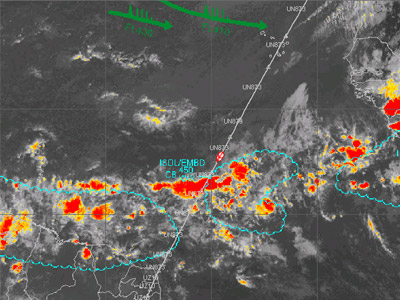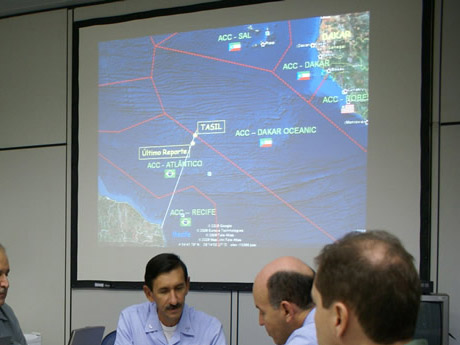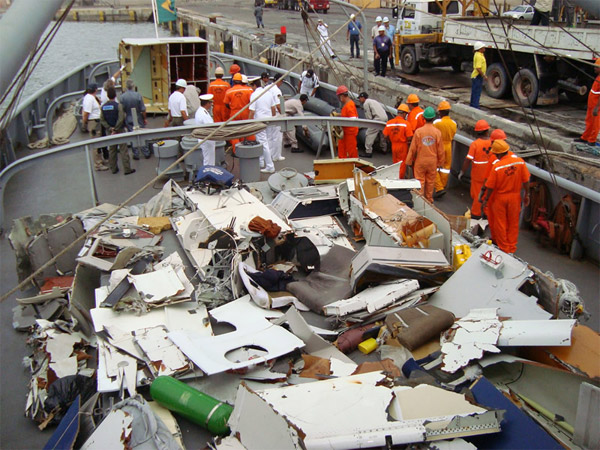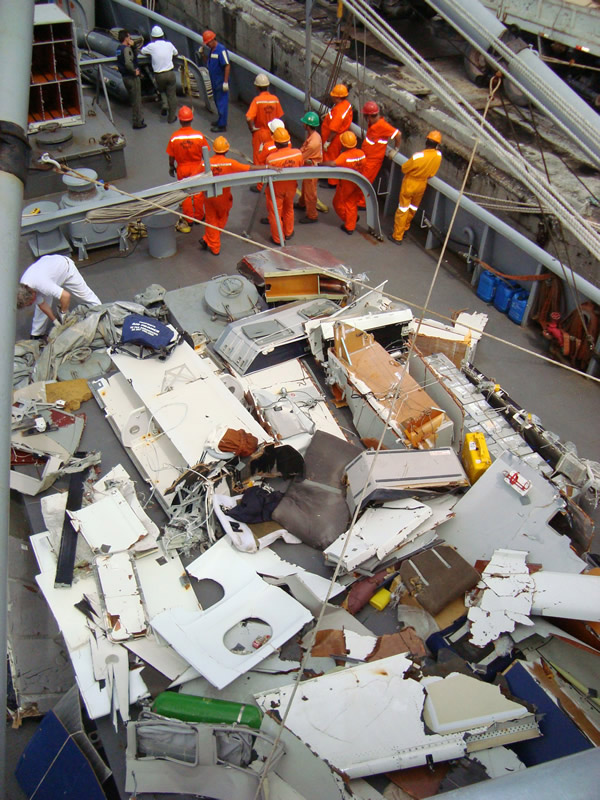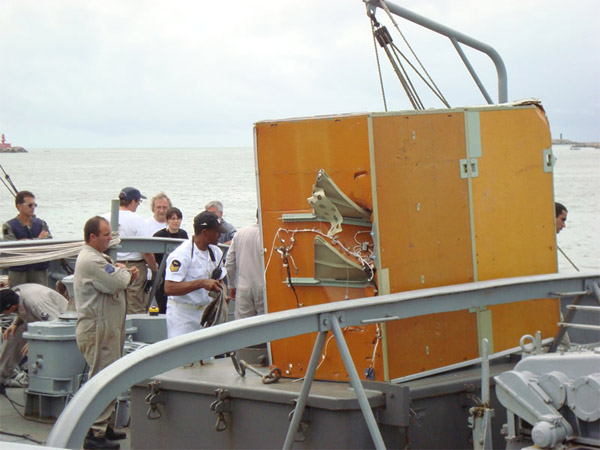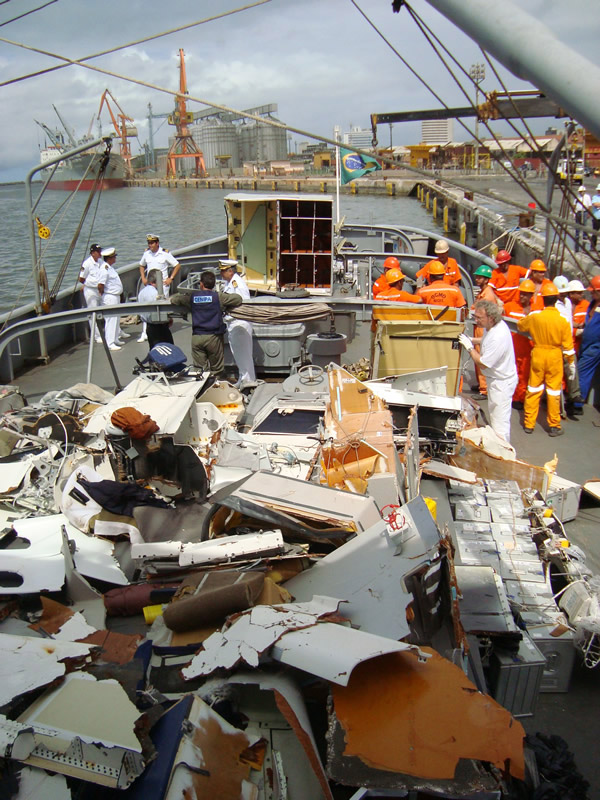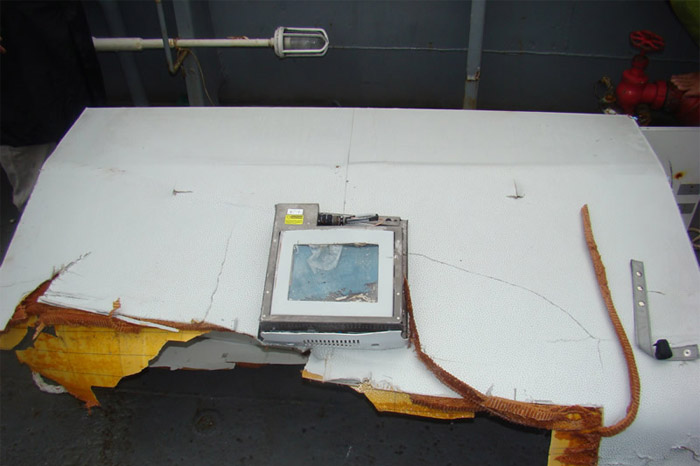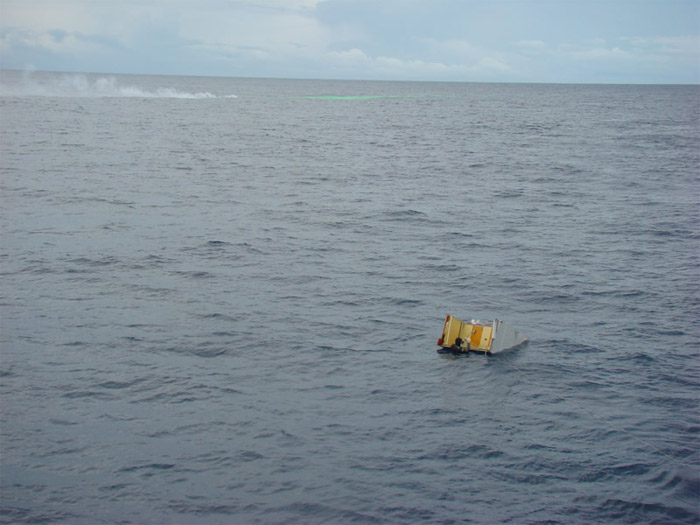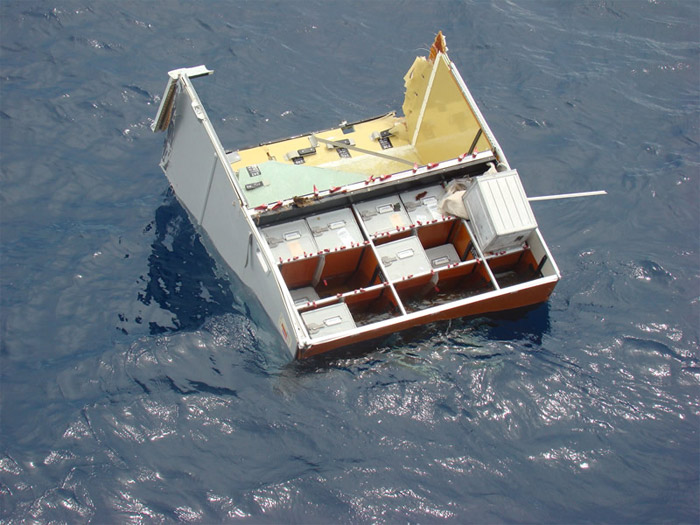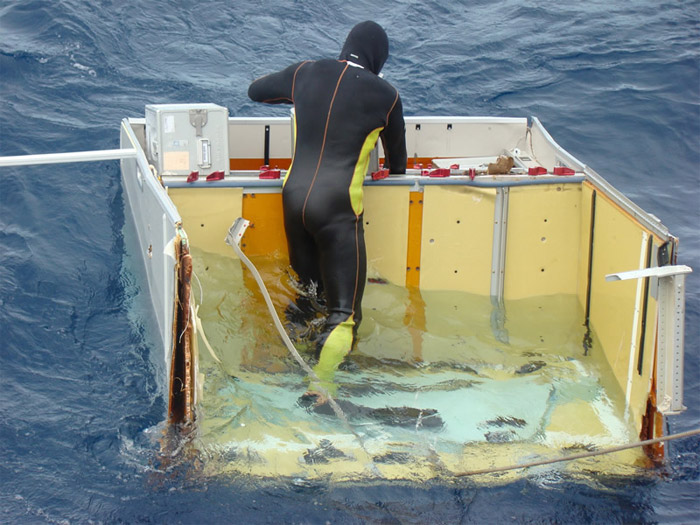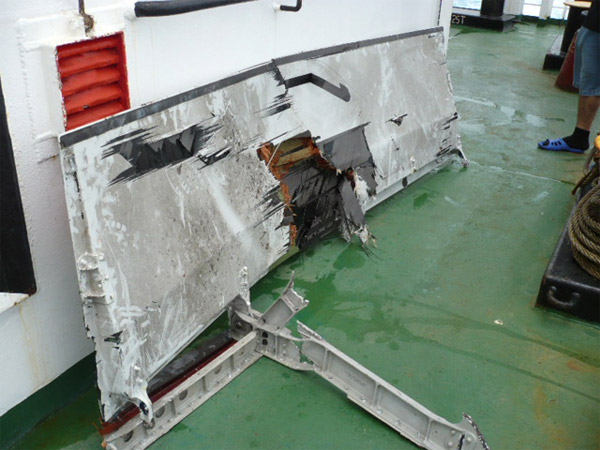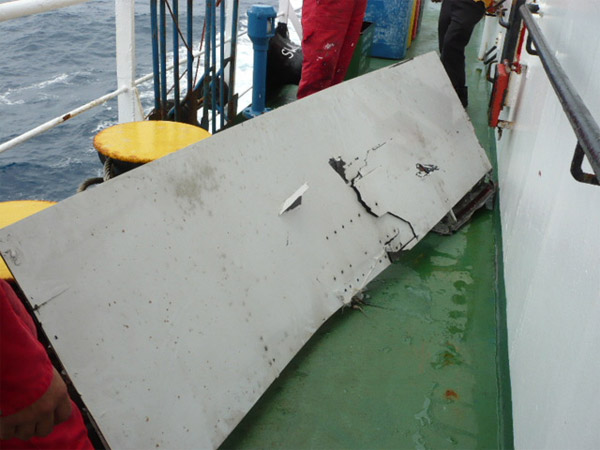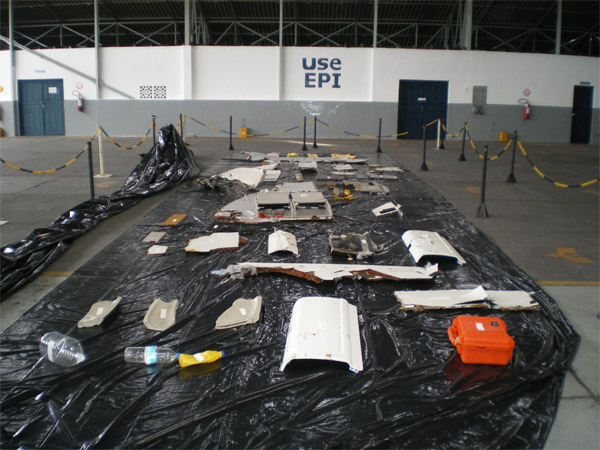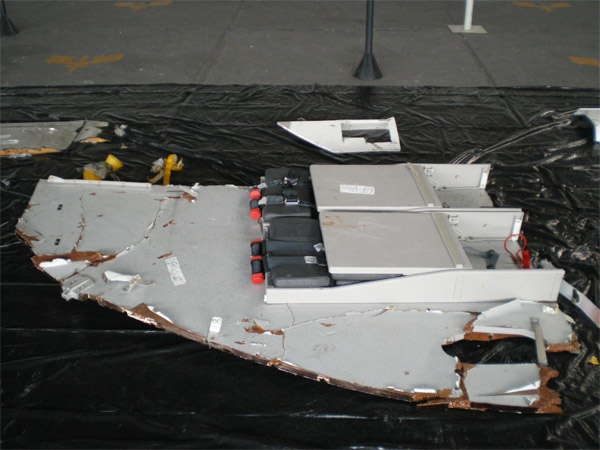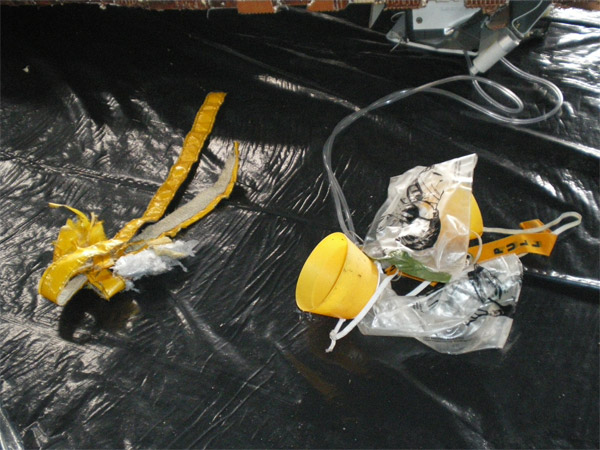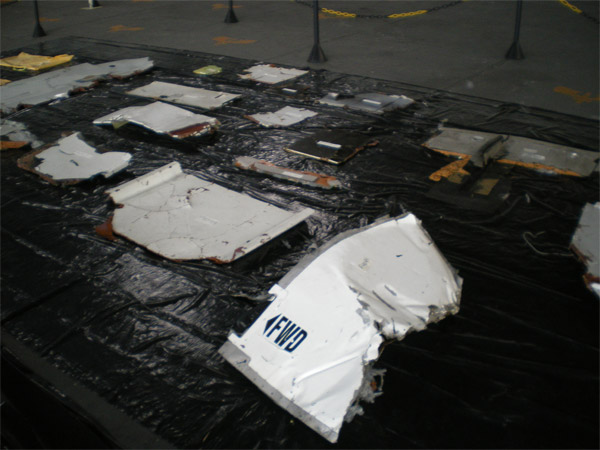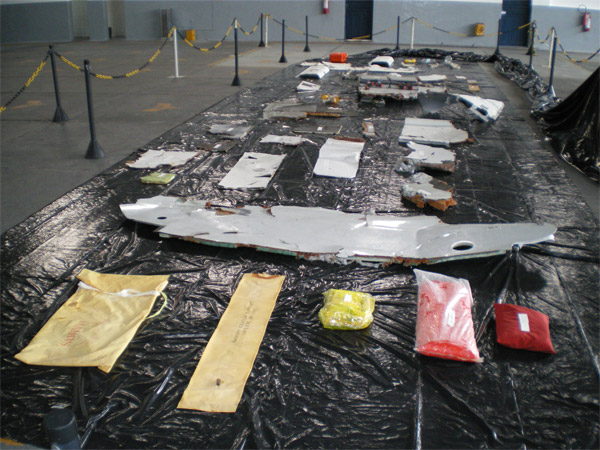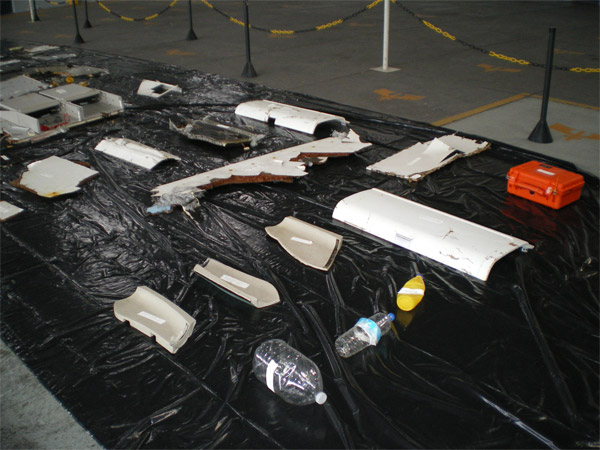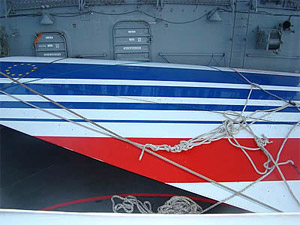Today, the French Bureau of Enquiry and Analysis for Civil Aviation Safety (BEA) has released a first intermediate investigation report on the Air France flight 447 crash from June 1.
The report reveals that the plane (Airbus A330-200 F-GZCP / MSN: 660) was not destroyed in flight and had likely struck the surface of the water in a straight line, with a high rate vertical acceleration.
The airplane had taken off from Rio de Janeiro without any known technical problems, except on one of the three radio handling panels. No problems were indicated by the crew to Air France or during contacts with the Brazilian controllers. No distress messages were received by the control centres or by other airplanes. The last radio exchange between the crew and Brazilian ATC occurred at 1 h 35 min 15 s. The airplane then arrived at the edge of radar range of the Brazilian control centres. At 2 h 01, the crew tried, without success for the third time, to connect to the Dakar ATC ADS-C system. Up to the last automatic position point, received at 2 h 10 min 35 s, the flight had followed the route indicated in the flight plan.
Weather
The meteorological situation was typical of that encountered in the month of June in the inter-tropical convergence zone. There were powerful cumulonimbus clusters on the route of AF447. Some of them could have been the centre of some notable turbulence. Several airplanes that were flying before and after AF 447, at about the same altitude, altered their routes in order to avoid cloud masses.
ACARS
Twenty-four automatic maintenance messages were received between 2 h 10 and 2 h 15 via the ACARS system. These messages show inconsistency between the measured speeds as well as the associated consequences. Before 2 h 10, no maintenance messages had been received from AF 447, with the exception of two messages relating to the configuration of the toilets.
The last ACARS message was received towards 2 h 14 min 28 s.
ACARS messages:
FLR = Fault
WRN = Cockpit Warning
- 02:10:10 – .1/WRN/WN0906010210 221002006AUTO FLT AP OFF
Autopilot disconnection other than by pressing the push-button provided for that purpose on the control sticks
- 02:10:16 – .1/WRN/WN0906010210 226201006AUTO FLT REAC W/S DET FAULT
Unavailability of the reaction to wind shear detection function
- 02:10:23 – .1/WRN/WN0906010210 279100506F/CTL ALTN LAW
Switching to alternate flight control law
- 02:10:29 – .1/WRN/WN0906010210 228300206FLAG ON CAPT PFD SPD LIMIT
02:10:41 – .1/WRN/WN0906010210 228301206FLAG ON F/O PFD SPD LIMIT
Disappearance of the display of the characteristic speeds (in particular VLS and green dot) on the Captain and First Officer PFDs, with display of the SPD LIM flag at the bottom of the speed scales due to unavailability of the FMGEC’s characteristic speed calculation function.
- 02:10:47 – .1/WRN/WN0906010210 223002506AUTO FLT A/THR OFF
Disconnection of the auto-thrust other than by pressing the button provided for that purpose on the throttle control levers (instinctive disconnect) or that the throttle control levers were moved to the idle notch.
- 02:10:54 – .1/WRN/WN0906010210 344300506NAV TCAS FAULT
TCAS is inoperative
- 02:11:00 – .1/WRN/WN0906010210 228300106FLAG ON CAPT PFD FD
02:11:15 – .1/WRN/WN0906010210 228301106FLAG ON F/O PFD FD
Disappearance of the Flight Director on the Primary Flight Displays, Captain and First Officer sides, and display of the red FD flag
- 02:11:21 – .1/WRN/WN0906010210 272302006F/CTL RUD TRV LIM FAULT
Unavailability of the rudder deflection limitation calculation function. The limitation value remains frozen at the current value at the time of the failure (until the slats extension command is given).
- 02:11:49 – .1/FLR/FR0906010210 34111506EFCS2 1,EFCS1,AFS,,,,,PROBE-PITOT
1X2 / 2X3 / 1X3 (9DA),HARD
02:11:55 – .1/FLR/FR0906010210 27933406EFCS1 X2,EFCS2X,,,,,,FCPC2 (2CE2)
/WRG:ADIRU1 BUS ADR1-2 TO FCPC2,HARD
Detection of different speed by pitot probes. Detection of decreasing speed of more than 30 kt in one second of the “polled†speed value.

- 02:12:10 – .1/WRN/WN0906010211 341200106FLAG ON CAPT PFD FPV
02:12:16 – .1/WRN/WN0906010211 341201106FLAG ON F/O PFD FPV
Disappearance of the Flight Path Vector (bird) on the PFDs (Primary Flight Displays), Captain and First Officer sides, and display of the red FPV (Flight Path Vector) flag
- 02:12:51 – .1/WRN/WN0906010212 341040006NAV ADR DISAGREE
The Electronic Flight Control Systems have rejected an Air Data Reference, and then identified an inconsistency between the two remaining Air Data References on one of the monitored parameters.
- 02:13:08 – .1/FLR/FR0906010211 34220006ISIS 1,,,,,,,ISIS(22FN-10FC) SPEED OR MACH FUNCTION,HARD
Internal failure at the level of the Calibrated Airspeed or Mach elaboration function. The Calibrated Airspeed or Mach values are outside certain limits.
- 02:13:14 – .1/FLR/FR0906010211 34123406IR2 1,EFCS1X,IR1,IR3,,,,ADIRU2(1FP2),HARD
Unexplained fault
- 02:13:45 – .1/WRN/WN0906010213 279002506F/CTL PRIM 1 FAULT
02:13:51 – .1/WRN/WN0906010213 279004006F/CTL SEC 1 FAULT
Flight Control Primary Computer 1 and Flight Control Secondary Computer 1 have stopped functioning.
- 02:14:20 – .1/FLR/FR0906010213 22833406AFS1,,,,,,,FMGEC1(1CA1),INTERMITTENT
Unexplained fault detected for less than 2.5 seconds
- 02:14:26 – .1/WRN/WN0906010214 213100206ADVISORY CABIN VERTICAL SPEED
A cabin altitude variation greater than 1,800 ft/min for five seconds.
Investigation of the recovered tail fin showed that the frames broke during a forward motion with a slight twisting component towards the left. A recovered galley was not very distorted. Baskets and racks were compressed in the lower part of both galley carts. The distortions observed in the metal vertical reinforcements of a toilet door showed evidence of great compressive forces. Fragments of the walls of the flight crew rest area were crumpled and those of the ceiling were deformed downwards. The floor was curved under the effect of a strong upward pressure from below. The connecting brackets between the floor and the walls were bent
backwards.
The agency also published further in-depth details about the weather at time of the crash, information about pitot probes, location of wreckage, as well as the general condition of the plane prior to the accident.
Also included in this investigation report is the full ATC transcript as well as some new photos of recovered wreckage.
Links
Intermediate Investigation Report (English) – Does NOT include several additional information such as ATC transcript and weather details!:
http://www.bea.aero/docspa/2009/f-cp090601e1.en/pdf/f-cp090601e1.en.pdf
Intermediate Investigation Report (French) – Complete report including ATC transcript and weather!:
http://www.bea.aero/docspa/2009/f-cp090601e1/pdf/f-cp090601e1.pdf
Source & Images: Bureau of Enquiry and Analysis for Civil Aviation Safety (BEA)
Related:
More New Photos of AF447 Wreckage
New Photos Of AF447 Wreckage
Photos – AF447 Wreckage
Photos – AF447 Tail Recovered from Atlantic Ocean

